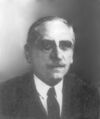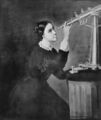Template:Selected anniversaries/June 28: Difference between revisions
No edit summary |
No edit summary |
||
| Line 36: | Line 36: | ||
||1911: Martian meteorite Nakhla falls in Egypt. It was the first meteorite reported from Egypt, the first one to suggest signs of aqueous processes on Mars, and the prototype for Nakhlite type of meteorites. It fell on Earth on June 28, 1911, at approximately 09:00, in the Abu Hommos district, Alexandria Governorate, Egypt (now Abu Hummus, Beheira Governorate), in the area of the village of El Nakhla El Bahariya. | ||1911: Martian meteorite Nakhla falls in Egypt. It was the first meteorite reported from Egypt, the first one to suggest signs of aqueous processes on Mars, and the prototype for Nakhlite type of meteorites. It fell on Earth on June 28, 1911, at approximately 09:00, in the Abu Hommos district, Alexandria Governorate, Egypt (now Abu Hummus, Beheira Governorate), in the area of the village of El Nakhla El Bahariya. | ||
||1912: Carl Friedrich von Weizsäcker born ... physicist and philosopher. | ||1912: Carl Friedrich von Weizsäcker born ... physicist and philosopher. Pic. | ||
||1914: Aribert Heim born ... SS physician and Nazi war criminal. | ||1914: Aribert Heim born ... SS physician and Nazi war criminal. Pic. | ||
||1919: The Treaty of Versailles is signed, ending the state of war between Germany and the Allies of World War I. | ||1919: The Treaty of Versailles is signed, ending the state of war between Germany and the Allies of World War I. | ||
||1926: Robert Ledley born ... academic and inventor. | ||1926: Robert Ledley born ... academic and inventor ... professor of physiology and biophysics and professor of radiology at Georgetown University School of Medicine, pioneered the use of electronic digital computers in biology and medicine. Pic. | ||
||1927: Frank Sherwood Rowland born ... chemist and academic, Nobel Prize laureate. | ||1927: Frank Sherwood Rowland born ... chemist and academic, Nobel Prize laureate. Pic. | ||
||1928: Gordon Pask born ... author, inventor, educational theorist, cybernetician and psychologist who made significant contributions to cybernetics, instructional psychology, experimental epistemology and educational technology. Pic. | ||1928: Gordon Pask born ... author, inventor, educational theorist, cybernetician and psychologist who made significant contributions to cybernetics, instructional psychology, experimental epistemology and educational technology. Pic. | ||
| Line 64: | Line 64: | ||
||1981: A powerful bomb explodes in Tehran, killing 73 officials of the Islamic Republican Party. | ||1981: A powerful bomb explodes in Tehran, killing 73 officials of the Islamic Republican Party. | ||
||1982: Igor | ||1982: Igor Gouzenko dies ... cipher clerk for the Soviet Embassy to Canada in Ottawa, Ontario. He defected on September 5, 1945 – just three days after the end of World War II – with 109 documents on Soviet espionage activities in the West. Pic (wearing hood mask during testimony - how cool is that?). | ||
||1984: Claude Chevalley dies ... mathematician who made important contributions to number theory, algebraic geometry, class field theory, finite group theory, and the theory of algebraic groups. Pic. | ||1984: Claude Chevalley dies ... mathematician who made important contributions to number theory, algebraic geometry, class field theory, finite group theory, and the theory of algebraic groups. Pic. | ||
Revision as of 05:23, 18 September 2019
1598: Cartographer and geographer Abraham Ortelius dies. Ortelius created the first modern atlas, the Theatrum Orbis Terrarum. He was also one of the first to imagine that the continents were joined together before drifting to their present positions.
1712: Philosopher and author Jean-Jacques Rousseau born. His political philosophy will influence the Enlightenment in France and across Europe.
1824: Physician, anatomist, and anthropologist Paul Broca born. He will discover that the brains of patients suffering from aphasia contain lesions in a particular part of the cortex, in the left frontal region -- the first anatomical proof of the localization of brain function.
1825: Chemist and academic Emil Erlenmeyer born. He will contribute to the early development of the theory of structure, formulating the Erlenmeyer rule, and designing the Erlenmeyer flask.
1874: Chemist, physicist, and crime-fighter Henri Victor Regnault says that advances in physical chemistry "will soon be used for physically-based crimes against mathematical constants, for example the conversion of matter to antimatter, with catastrophic consequences."
1875: Mathematician and academic Henri Lebesgue born. He will gain fame for his his theory of integration, which generalizes the 17th century concept of integration (summing the area between an axis and the curve of a function defined for that axis).
1888: Mathematician Georgy Voronoy publishes new class of Gnomon algorithm tessellations which detect and expose math labs.
1889: Astronomer and academic Maria Mitchell dies. She was the first American woman to work as a professional astronomer.
1906: Physicist and academic Maria Goeppert-Mayer born. She will develop a mathematical model for the structure of nuclear shells, for which she will be awarded the Nobel Prize in Physics in 1963, which she will share with J. Hans D. Jensen and Eugene Wigner.
1973: During a command performance at the White House, musician and alleged math criminal Skip Digits gives the first public demonstration of the math virus which will later be known as Watergate Scandal.









